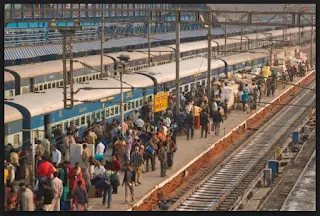Urban growth gives rise to economies of scale. Industries benefit from concentrations of suppliers and consumers which allow savings in communications and transport costs. Large cities also provide big differentiated labour markets and may help accelerate the pace of technological innovation. Urban growth also allows economies of scale in such services as water supply and electric power to be exploited. Evidence from India suggests that substantial economies of scale are found in cities of up to 150,000 inhabitants.
Against these benefits, a major consequence of rural-urban migration is over-urbanisation. In other words, at some point, diseconomies of scale begin to emerge as cities become too big, although the city size at which these become important has not been demonstrated.
Along with the rapid spread of urbanisation has come the prolific growth of huge slums and shanty towns. Today, slum settlements represent over one-third of the urban population in all developing countries; in many cases they account for more than 60% of the urban total. The enormous numbers of squatters and slum-dwellers, who account for half the populations of cities as diverse as Istanbul, Dar es Salaam and Caracas are a visible sign of the ‘lottery’ described above.
Surveys confirm that air pollution, congestion, social disturbances, crime and similar problems increase disproportionately with city size. The concentration of people also causes congestion and raises the cost of travel so that scarce resources like time and fuel are wasted. In addition, the mounting pressure on existing services means deteriorating quality and a reduction of what is available per person. As cities expand, the cost of providing basic services can rise enormously.
Over-urbanisation and its related problems (pollution, noise and congestion) are examples of negative externalities. The presence of such externalities causes a market to operate inefficiently. The market failure will lead to a free-market solution which tends towards over-urbanisation or to a size of city that is above the socially desirable one, because there is a clear divergence between private and social marginal costs (i.e. social costs = private costs + external costs).
This idea can be understood from Figure 4. Migrants impose costs on others e.g. congestion, pollution, noise, etc. This is represented by placing marginal social cost curve (MSC) above the marginal private cost curve (MPC) in Figure 4. In this case private costs fail to coincide with social cost because the true social cost is equal to the private cost plus the cost that migration imposes in terms of overcrowded cities. Since the social marginal cost of migration to cities exceeds the private marginal costs, there is a clear sign that too much migration is taking place. Migrants face a choice of whether to stay in the rural areas or to migrate to the city. They will migrate as long as the benefits of migration exceed the their private costs. So migration takes place up to the point where marginal private cost is equal to the marginal private benefits i.e. MPC=MPB and where the size of cities is Q0. However, the optimal size of cities is Q*. Thus, the distance Q*Q0 represents the negative external effects of migration on city-dwellers i.e. the degree of over-urbanisation in cities or the extent to which large cities are too big.
Conclusions
Despite the huge social costs of rural-urban migration, people are still moving to overcrowded cities. This tendency can be understood as a response to large urban-rural wage differentials maintained by minimum wage laws and restrictive practices. Because of the externalities involved in migration decisions there is a good reason to suppose that unregulated markets will tend to promote over-urbanisation. As long as the private costs of migration are less than the social costs and migrants are willing to risk not finding a high-wage job, over-urbanisation is likely to continue to be a serious problem for developing countries.
Review Notes
1. Huge and growing cities are a feature of many developing countries - it is predicted that by early next century 22 of the worlds largest 27 cities will be in developing countries.
2. Whilst cities may have a certain lure in terms of ‘bright lights’ it is economic factors that largely explain this the tendency towards urbanisation - urban wages are very substantially higher than rural wages.
3. High urban wages are maintained by minimum wage laws, union pressure and the presence of high-wage employers (often governments and multinational corporations) so equilibrium is reached not by the adjustment of wages but by high unemployment.
4. The fact that it is mostly the young and the educated who migrate supports this economic explanation of rural-urban migration because these workers have the most to gain in terms of lifetime earnings.
5. Decisions to migrate to urban areas result in many external costs as cities become large – pollution, noise and congestion are some examples of these external costs.
6. In the presence of migration externalities it is likely that there will be over-urbanisation.
by Shashikant Nishant Sharma











